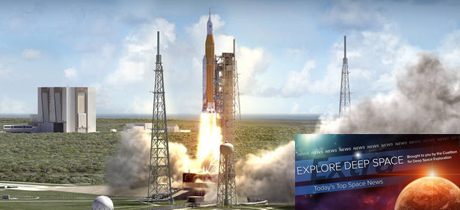In Today’s Deep Space Extra… NASA intends to establish a new launch date for Exploration Mission-1 by early fall. EM-1, the first test flight of the Space Launch System and the Orion crew capsule had been planned for late 2018.
Human Deep Space Exploration
NASA agrees with GAO — First SLS/Orion mission will slip to 2019
Space Policy Online (4/27): NASA’s Exploration Mission-1, the first joint test flight of NASA’s Space Launch System rocket and Orion crew exploration capsule, has slipped from late 2018 to 2019, according to an assessment from the U.S. Government Accountability Office made public on Thursday and with which NASA concurs. NASA is to provide an updated assessment of launch plans by Sept. 30. NASA has also assessed adding astronauts to the previously unmanned test launch that is to send Orion around the moon and back to Earth.
Cruz to Congress: America must settle space first
Daily Caller (4/27): The U.S. must settle space first, U.S. Sen. Ted Cruz tells fellow lawmakers and others gathered for a hearing of the Senate Subcommittee on Space, Science and Competitiveness. Cruz chairs the panel, which called for testimony from U.S. commercial space companies.
Space Science
‘Giant hurricane’ on Saturn: 1st images back from Cassini’s epic ring dive
Space.com (4/27): The first Images from the Cassini mission spacecraft’s first dive between Saturn’s atmosphere and the innermost of the planet’s famous rings reached Earth early Thursday. Cassini, which has orbited Saturn since 2004, carried out the first of 22 “ring dives” a day earlier. At the final pass in September, Cassini will break up in Saturn’s atmosphere. The long-running mission is a joint effort by U.S. and European space agencies.
Waiting for Cassini: Scenes from a late night at NASA’s Jet Propulsion Laboratory
Los Angeles Times (4/27): Scientists at NASA’s Jet Propulsion Laboratory entertained themselves with song and camaraderie late into the night this week as they awaited word on the fate of the Cassini probe nearly 24 hours after the spacecraft silently dove between Saturn and its ring system for the first time.
NASA’s Dawn probe at dwarf planet Ceres loses another reaction wheel
Space.com (4/27): NASA’s Dawn spacecraft, which has been orbiting the main belt asteroid Ceres since the spring of 2015, has experienced the loss of a third reaction wheel, or steering device. The space agency was prepared for the possibility of the loss. Dawn, which launched in 2007, is now in an extended mission phase and using the remainder of its fuel supply to maneuver the spacecraft.
Low Earth Orbit
China’s cargo spacecraft completes in-orbit refueling
Xinhuanet (4/27): China’s Tianzhou-1 cargo mission spacecraft, launched April 20, successfully demonstrated an automated refueling of the current unmanned Tiangong-2 orbiting space lab on Thursday. The achievement is considered an important step in China’s plans to assemble a permanently staffed space station, beginning in 2018.
China to conduct several manned space flights around 2020
Xinhuanet (4/28): With the successful automated refueling of the Tiangong-2 orbiting space lab behind it, China’s space program is ready to enter a “space station” era, according to Wang Zhaoyao, director of China’s manned space program. The refueling test this week set a stage for the orbital assembly of a permanent space station beginning in 2019, he said.
Ground control to Major Tom: the history of the Space Wake-Up Call
Popular Mechanics (4/27): NASA’s iconic astronaut wake up call, a tradition from Gemini 6 in 1965 through the final space shuttle mission, STS-135, in July 2011, may be coming back. NASA has assembled a history of the tradition to set the stage.
Veteran Russian cosmonaut Gennady Padalka, three others resigning
Spaceflight Insider (4/27): At least four veteran Russian cosmonauts, Gennady Padalka, Sergey Volkov, Alexander Samokutyaev and Sergey Revin, will be departing Russia’s cosmonaut corps.
Commercial to Orbit
U.S. satellite rules are out of focus. It’s time for new vision.
Space News (4/27): In an op-ed, U.S. Rep. Brian Babin, who chairs the U.S. House Science, Space, and Technology subcommittee, urges regulatory changes that encourage growth of the space commercial sector involved in remote sensing. An array of new technologies are opening new opportunities since the most recent legislation in 1992, according to Babin.

